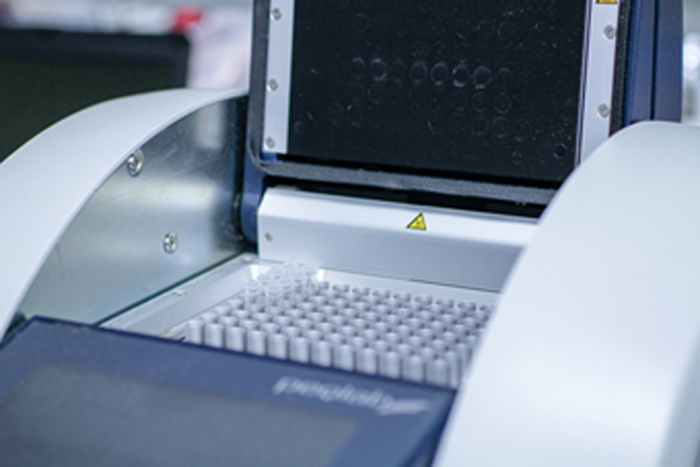How PCR Product Mutations Affect Sequencing Results
One of the main advantages of sequencing a PCR product directly (as opposed to cloning it first) is that you will not see PCR-generated mutations. The reason for this is that you have a large population of templates in your initial PCR reaction and even a mutation introduced in one PCR product in the first round of amplification will only be present in that one product out of thousands produced by the reaction. This very low frequency means that this error is swamped out by the majority (correct) sequence and so is not seen. As the reaction proceeds, the error is propogated, but so is the proportion of correct sequence at the same place in other templates. Hence, the error is still only present at a very low frequency and is not seen.
Contrast the above scenario with what happens when you clone the PCR product. Each clone is obtained originally from a single PCR product being inserted into a single vector. Hence, if that product contains an error, all the cloned plasmids derived from it will contain the same error. For this reason, one must sequence at least three independent clones in order to be sure that you are seeing the actual sequence and not a PCR-generated error.
PCR Primers vs Sequencing Primers
If your PCR primers are very long (over 30 bases), then it will probably be best to make shorter primers for performing the sequencing. This is because the very long primers might give a high background.
You may also wish to use "nested primers". These are primers that will bind slightly further into the PCR product than the primers used for PCR. This only needs to be a few bases. What this does is prevent any non-specific PCR products from taking part in the sequencing reaction and can, therefore, produce a much cleaner sequence. Customers are strongly advised to consider the use of nested primers.
Purification of PCR products
In order for direct sequencing of PCR templates to work well, it is critical that customers provide “cleaned” PCR products to remove unwanted PCR products (if present) and remove (or dilute) excess PCR primers and remaining dNTPs from the PCR reaction. Failure to do this is very likely to result in a messy sequence result.
There are various options available for performing PCR product purification. What will work the best in each case depends on various factors.
EXO-SAP
- If you have a very clean and strong single band, you might want to try EXO-SAP. This is a very simple method that removes residual primers and dNTPs (these are the things that cause problems for sequencing as noted above).
- The benefit is that you don't lose any product (it just gets diluted a little).
- However, this will not remove extraneous PCR products, so only works if you have a clean single band. It also will not remove primer dimers.
Column Purification
- Any of the various column purification kits available will also work to remove primers and dNTPs.
- Yield is likely to be less than EXO-SAP, but it might remove primer dimers since these may not "stick" to the column.
- An alternative is to use a size cut-off membrane centrifugation approach to remove small molecules (dNTPs, primers, buffer components).
Gel Purification
- Gel purification is also an option and needed if you do not have a single pure PCR product.
- The trouble with this approach is that yield can be low and you run a real risk of introducing extra contaminants into the prep in the form of components from the agarose gel.
- It is vital to use a high quality agarose if doing gel purification.
Dilution of PCR Productions
- A simple option is to dilute your PCR product in water with no further cleanup.
- If you have a well optimised PCR reaction, the residual primers and dNTPs will be low and diluting may be all that is necessary.
- For this approach to work, you need to have a single strong PCR product present.
Methods for Quantitating PCR Products
Please note that it is critical that quantitation of PCR products is not done with a spectrophotometer (such as a nanodrop). Rather, evaluation on an agarose gel provides a more accurate estimate.
Most of the absorbance can often be from free dNTPs and primers and not from the PCR product. Hence, customers often over-estimate the yield and consequently send far too little PCR product.
This is especially important if you clean up your product by EXO-SAP or simply diluting it. What is needed is a ball-park concentration for the PCR product – it does not need to be picogram accurate.
For this reason, estimation on an agarose gel is best:
- Run a known volume of PCR product on a gel and also run a size marker (a couple of different loadings is good).
- Look at it and pick a marker band that is close in intensity and size to the PCR band.
- The marker product sheet will tell you that if you load Xµl, band Y will have Z nanograms of DNA in it.
- Hence, you can calculate your nanogram amount of PCR product and can work out the concentration.
- You can also use software to interpret the gel image and work this out for you, but that is not really needed once you are familiar with estimating by eye.
It is important that any estimation of yield is done right at the end of the cleanup process, in case the product is lost during purification.


